FC Thun were synonymous with the Swiss Super League during the 2010s, spending the entire decade in the top-flight. However, they endured a poor 2019/20 season, finishing ninth with just 38 points to suffer relegation. They have been looking for a way back ever since and even finished second in the following campaign but lost to FC Sion in the playoffs. The next two seasons saw them finish fifth and sixth.
This time around, though, Thun are on course for the playoffs and potentially promotion itself. They are currently second in the Swiss Challenge League with 54 points from 27 matches, six adrift of Sion, who have played a game more. After conceding 55 or more goals in six of the last seven league seasons, they are on course to concede only around 41 goals this term (31 conceded so far).
The man behind it all is former Thun player Mauro Lustrinelli, who was in charge last season as well but struggled to get his term to perform consistently. This tactical analysis report will thus look at the statistical strides Thun have taken this season and Lustrinelli’s tactics, and provide an analysis of clips from their matches to understand what has led to their improvement.
Background
Lustrinelli’s 11-year-long playing career took him to multiple clubs. He began his career with FC Wil 1900 in the summer of 2001 before joining Thun two-and-a-half years later. His debut season at the club went brilliantly, as he netted 24 times in 39 matches across competitions. The following season, he played for the club in the UEFA Champions League and netted 16 times in 29 games before being sold to Sparta Prague in the 2006 winter transfer window.
Lustrinelli then went onto play for Luzern and BSC Young Boys, while also spending a couple of seasons with AC Bellinzona, before returning to Thun in 2011. He announced his retirement midway through the campaign in early 2012, bringing an end to career that saw the former centre-forward score 149 goals and lay out 47 assists in 396 matches across competitions. He also won 12 caps for Switzerland, even playing twice at the 2006 FIFA World Cup.
Upon retiring, Lustrinelli took up the assistant manager role at Thun in January 2013, doubling up as their academy manager as well. He then oversaw both their U18 and U21 teams before taking the assistant manager role with Switzerland’s U21 side in March 2015. Midway through a nearly three-year spell in that role, he was appointed as a caretaker manager at Thun from March to June 2017, helping them record five wins and three draws in 11 matches.
From 2017 to 2018, he also served as Switzerland U16’s manager and caretaker manager for their U21s. This led to him getting the U21s head coach job in June 2018, and Lustrinelli led the team to 20 wins in 30 matches across four years. In the summer of 2022, he returned to Thun, this time as their first-team manager.
FC Thun 2023/24: What’s changed statistically from last season?
A quick look at the statistics show some key changes in Thun’s defensive and possession approach this season as compared to 2022/23.
The defensive stat pack below suggests that they are pressing a little less intensely than last season while winning a similar percentage of their defensive and aerial duels. They have been more active in clearing the ball and have given away fewer fouls.
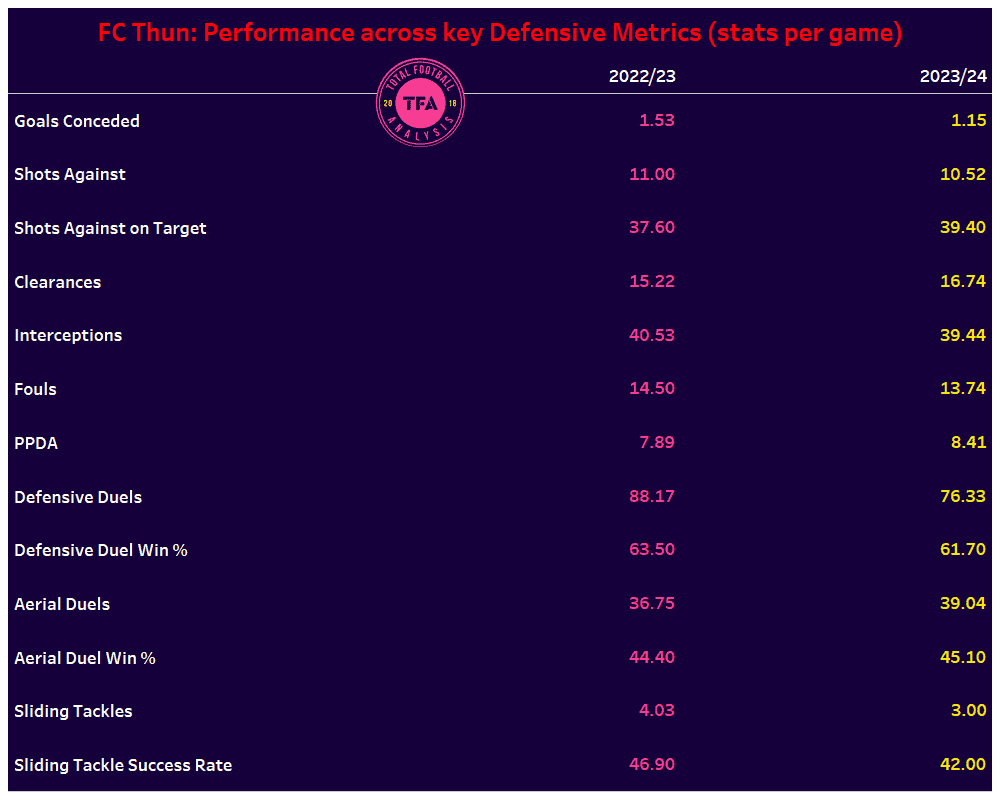
This, however, doesn’t entirely explain their improvement, and their passing and possession performance help paint a more complete picture.
In this regard, a lot of their changes have to do with a shift from a volume-based approach to a more quality-based one. Their numbers in several metrics, including forward passes, passes into the final third and long passes, have fallen, while the accuracy of those efforts has increased. They have also minimised their losses of possession, which has led to reduced effort in recoveries, thus improving their defensive solidity.

Formations and Personnel
Lustrinelli has largely used a 4-3-1-2 formation at Thun this season, very rarely reverting to a 4-1-3-2 or a 4-2-3-1. Mateo Matic has been a constant in goal, starting all of their 27 Challenge League matches. In front of him, the left-back slot has been a toss-up between summer arrivals Kévin Djacko and Dominik Franke, while Lucien Dähler has made the right-back position his own. Marco Bürki has been a constant at centre-back, with Nicola Sutter and Jan Bamert receiving minutes alongside him.
Ahead of them, Vasilije Janjicic has been a consistent starter at the base of midfield. He has often been joined by Justin Roth on the left side, while the right-sided central midfielder role has largely been shared by Leonardo Bertone and Valmir Matoshi. Ahead of them, Daniel dos Santos has been the undisputed option as the 10. Summer signing Koro Koné has been the most consistent starter upfront, while another summer arrival, Ihsan Sacko, Rolando Ndongo, Marc Gutbub and Nando Toggenburger, have all received minutes upfront as well.
Sacko and attacking midfielder Miguel Castroman have been Lustrinelli’s most-used substitutes in the league, with 17 appearances each off the bench. They are followed by centre-forward Hélios Sessolo (15), Ndongo, Gutbub and Toggenburger (12 each), and Matoshi (8).
Defensive Organization
Pressing and Territory
As indicated by their passes per defensive action (PPDA) figure, Thun, despite a slight drop, remain a side that presses opponents high up the pitch. Lustrinelli’s men often commit five or six players into the opposition half and consistently track players to ensure there is no easy pass. This becomes evident in the following sequence from their 1-0 defeat to Vaduz in their latest fixture.
Here, they commit multiple men forward and trap Vaduz close to their own box. They eventually concede a foul but notice how they allow no easy passes, with each presser tasked with marking an opponent and seven players in the opposition half by the last frame.
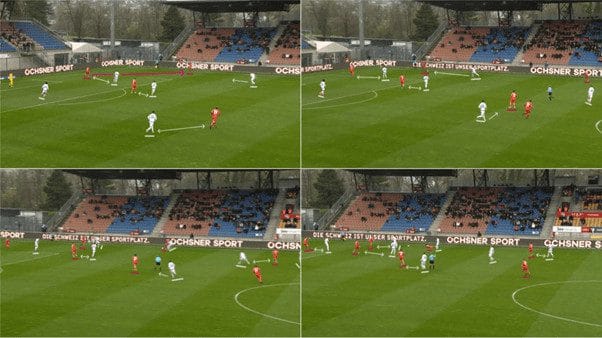
This can also be viewed in this play from their 2-1 win away to league leaders Sion. Here, one of the three central midfielders presses up along with the two forwards, while the attacking midfielder presses one of the opponents near the centre circle.
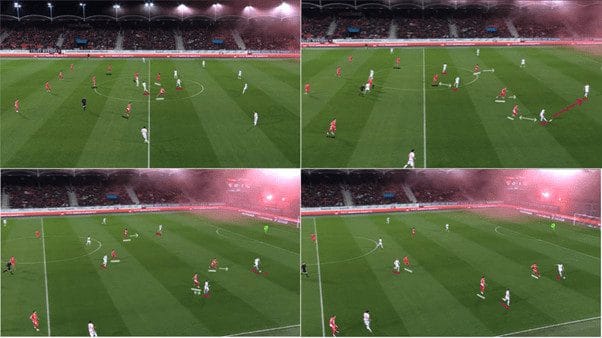
Overall, their pressing has been smarter, with the focus once again on quality over quantity. As the map below shows, their high regains, counter-pressing recoveries and dangerous recoveries have dropped substantially. Additionally, there seems to be an increased focus on cutting down passes in wider areas rather than central ones.
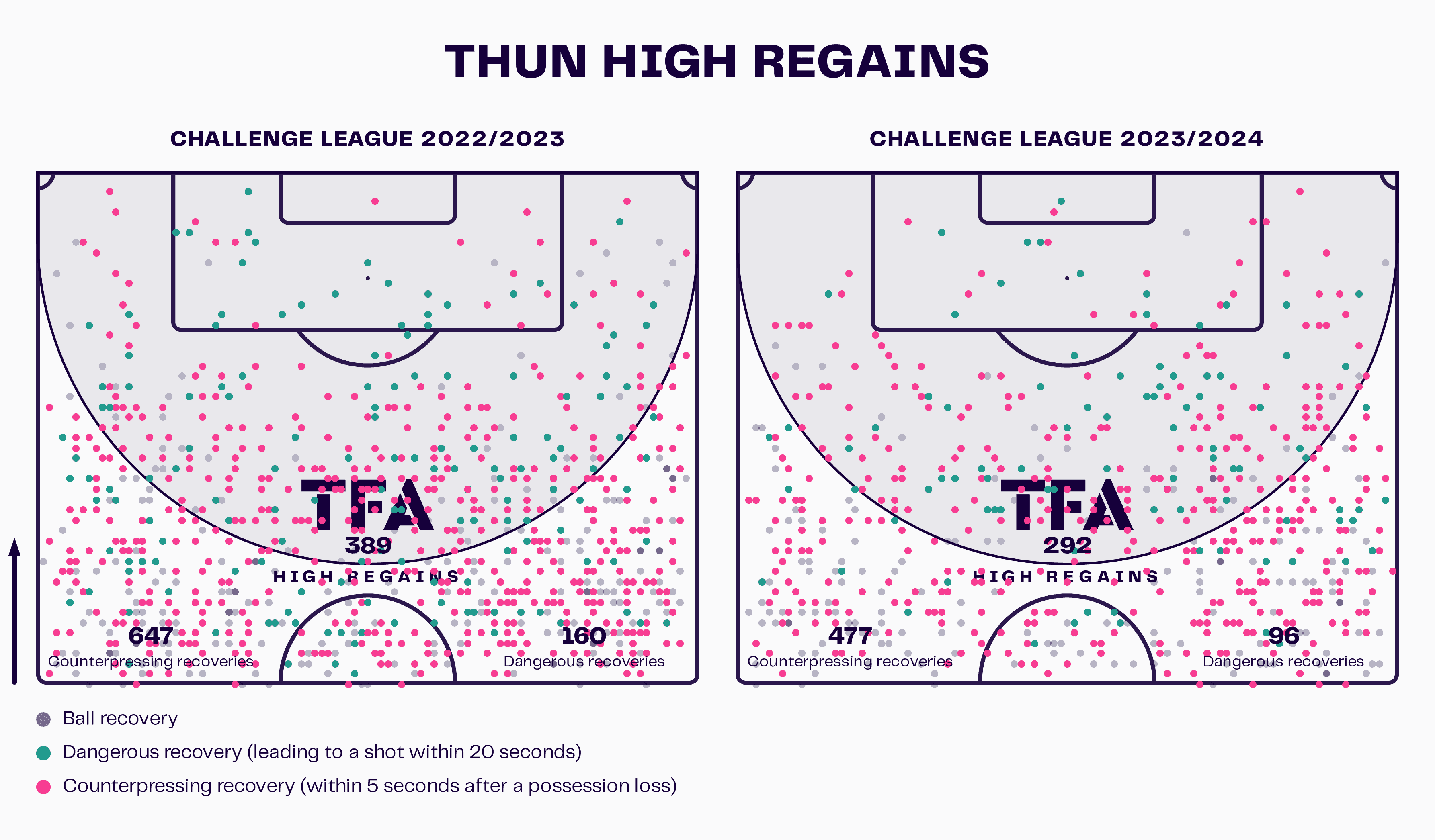
This has, in turn, led to the team sitting slightly deeper than they did last season, as their defensive territory map below shows. Notice, however, that the top half of their territory is virtually the same from last season, with marginally more width. In essence, Thun have exchanged higher pressing for more defensive solidity, which bears out in the stats as well. They also seem to be benefitting from this move and look more organised at the back when they defend. Here as well, the map indicates increased activity in wider areas.
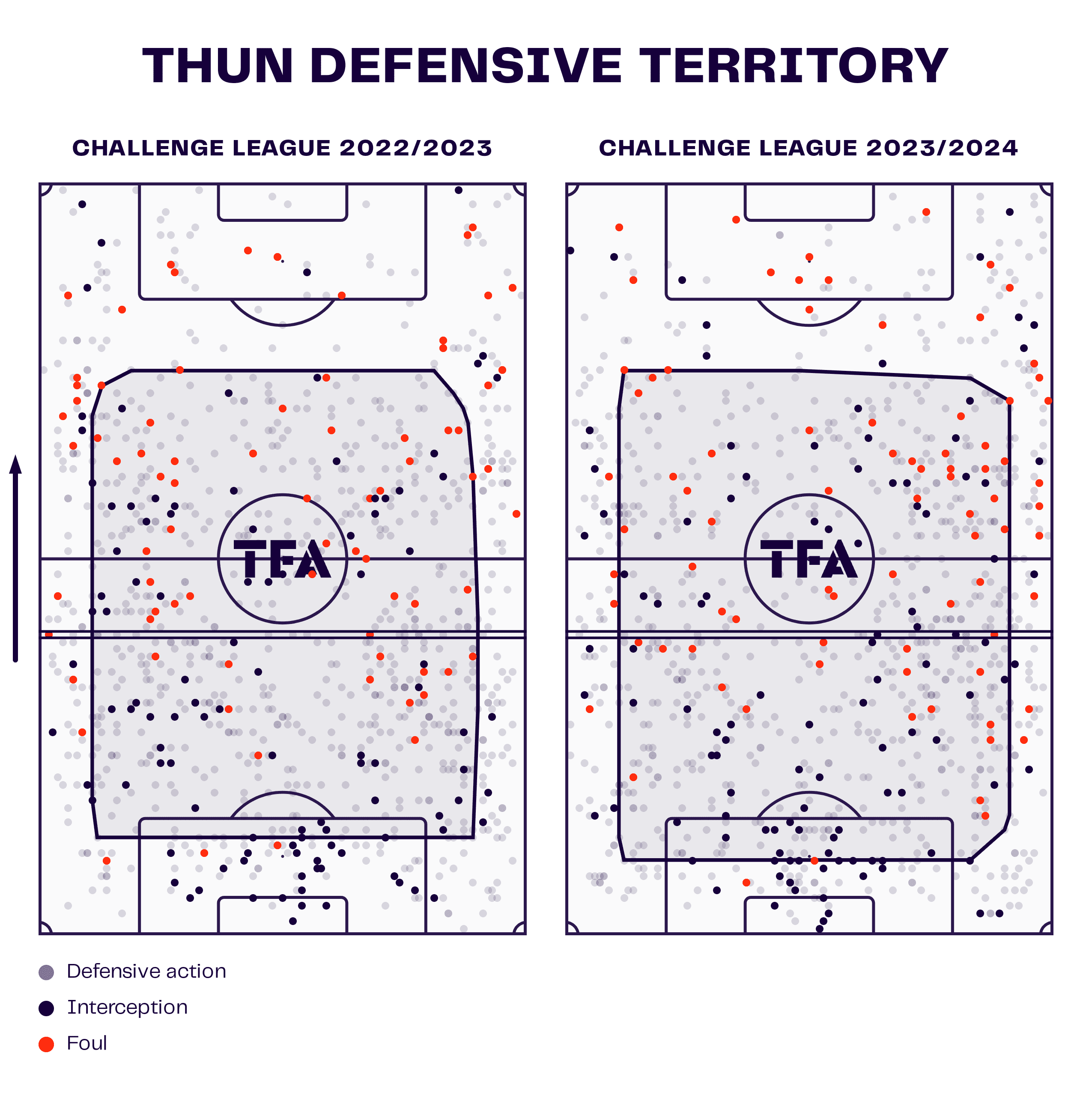
Set-piece Defence
Another key aspect of Thun’s defensive improvement this term has been their efficiency in clearing out set-pieces, particularly corners. Their opponents have gotten shots away from less than 30% of their corners and free-kicks. A look at the sequence below from their 3-1 win over Baden shows their organisation from corners.
Thun deploy a largely man-marking system, tracking every single opponent player in the box, while one of their defenders guards the near-post. They leave the far-post open in this case as no Baden player tries to attack the ball from there, while they keep one man within touching distance of an opponent on the edge of the box. This move ends with the goalkeeper, who has ample protection around him in the form of three defenders, punching the ball out to the opposite wing.
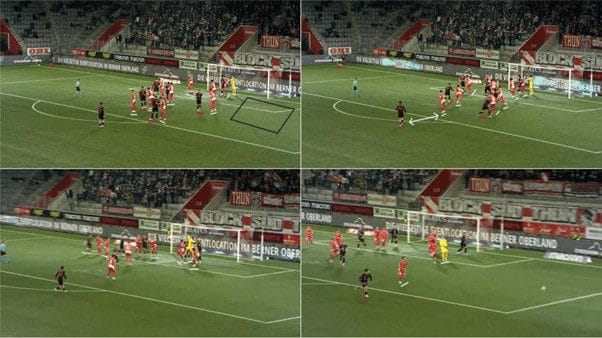
Thun’s defending from corners is also adaptable, as they display against Wil below. Wil utilise a system that sees their players attack the penalty spot after initially lining up near the edge of the box. Thun match them, while keeping men at both posts and an extra player to close down a potential short-pass. However, they are tricked as one Wil player blocks a defender to let another get a free run into the box. Fortunately for Thun, the defender at the near-post gets his head to the ball first.
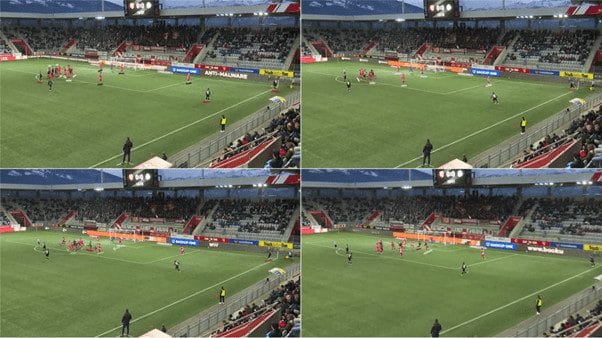
Open-play Defending and Shape
In open play, Thun’s set-up sees them line up in their formation. Once the opponent stitches a few passes together, they fall into a shape where one of the full-backs presses up while the remaining three are protected by a line of three midfielders (all central or two central and the attacking midfielder), with the two forwards and final midfielder forming the first line of defence. However, they initially commit all of their front six to the press during the build-up.
Consider the following sequence from their 4-0 defeat to Neuchâtel Xamax. We initially see six Thun players in the opposition half, but they eventually begin dropping back. The first time the ball is played down the left wing, the right-back instantly engages, but the Xamax player finds an open pass to midfield thanks to another player starting a run into the space vacated by the right-back and drawing the attention of the midfielder’s marker.
The ball, however, eventually ends back with the Xamax centre-back, and we see the Thun right-back retreat, as well as the two lines of protection for the defence, with the first line moving towards the ball and the second line moving into the spaces on the wing the ball is moving to. Thun’s defensive organisation forces the backwards pass, but it’s worth noting that Xamax initially play their way out against the press quite well.
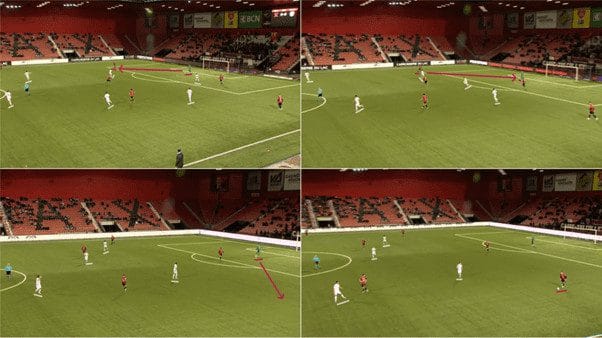
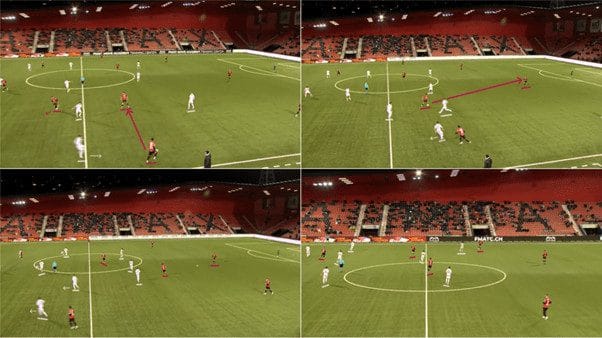
Weaknesses and Goals Conceded
One area where Thun have struggled this season is when dealing with counterattacks. As many of 51.8% of the counterattacks they concede end up in shots, posing some threat to their goal as they commit numerous players to their attack.
One example of this came in their defeat to Xamax, where they failed to track the runners after ceding possession, resulting in a tap-in into an empty goal. Notice how the move begins effectively with a one-on-one, with Thun scrambling back to get numbers in their own half.
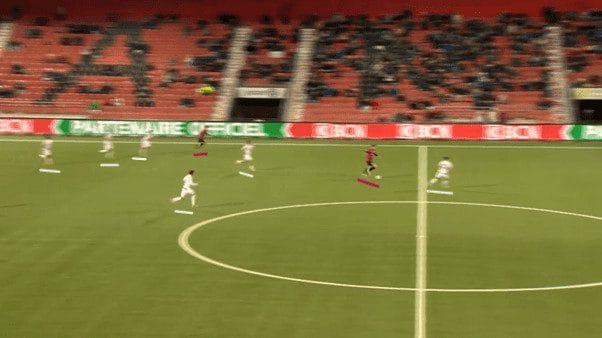
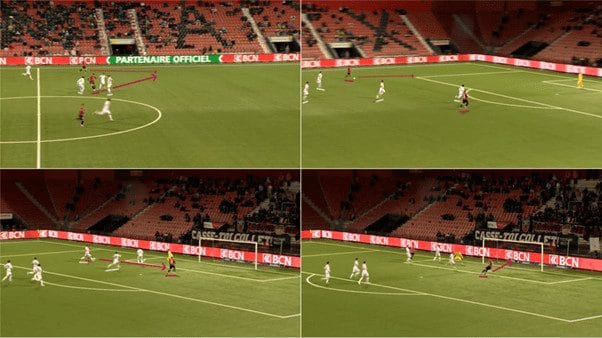
The reason Thun struggle on the counterattack is their tendency to at times move strictly towards the ball, which leaves them vulnerable to clever passes like in the case above.
The more obvious way this can hurt them is in leaving space by over-committing, something we see in the sequence below from their match against Baden, where the left-back over-commits and makes an ordinary play for the ball, leaving far too much space behind him. Additionally, in a system based on structure, even the slightest lapse in concentration could hurt the team. In this case, a Baden player is easily able to collect a throw-in as his marker is slow to retreat towards him.
The move ends in a goal as the rest of the defence is unsettled and fail to close down a player inside the penalty area. As the bottom-right panel shows, Thun would have also been vulnerable from a cut-back.
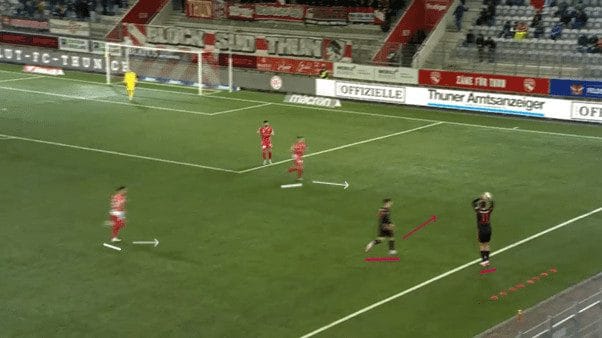
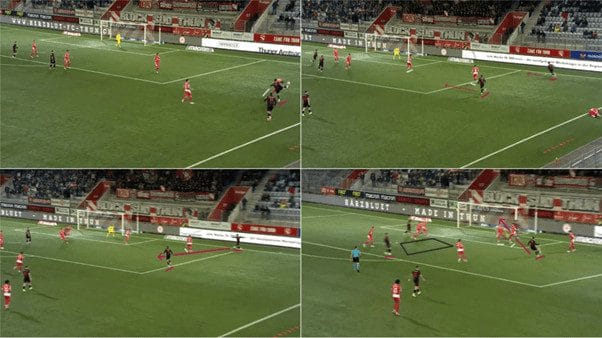
Conclusion
Lustrinelli’s Thun have taken massive strides defensively this season and this is evident from both stats as well as in-match footage. Their improved defensive performance has seen them put themselves in the race for promotion, and with nine matches to go, they could even jump to the top of the table and avoid the playoffs.
However, they still have to address a few concerns, notably with respect to defending counterattacks and staying more poised and focused with both their pressing and defending to not concede avoidable goals. Overall, however, Lustrinelli’s project is shaping up quite nicely and Thun are a side to monitor for the rest of the season.





Comments